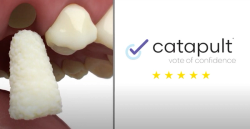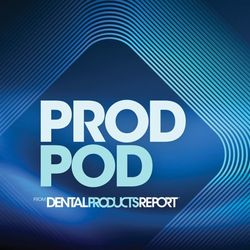- About Us
- Advertise
- Editorial
- Contact Us
- Terms and Conditions
- Privacy Policy
- Do Not Sell My Personal Information
© 2025 MJH Life Sciences™ and Dental Products Report. All rights reserved.
How to take predictable impressions
There’s potential for confusion among practitioners because of the abundance of currently available materials and techniques. Many excellent materials are available, however they all require meticulous attention to clinical technique to record the accuracy necessary for fabrication of well-fitting restorations.
There’s potential for confusion among practitioners because of the abundance of currently available materials and techniques. Many excellent materials are available, however they all require meticulous attention to clinical technique to record the accuracy necessary for fabrication of well-fitting restorations.
Meticulous preparation techniques and respect for biologic principles create an environment from which an excellent impression can be taken. Scrupulous gingival retraction, hemostasis and a coordinated dental team provide the circumstances from which successful dental impressions can be accomplished. All of these clinical efforts are accentuated with the use of a superior impression material.
Using Kettenbach LP’s new Identium® impression material and a clinically predictable technique can capture excellent marginal detail.
About the material
Identium is a Vinylsiloxanether (VSXE), a proprietary formulation that boasts a successful combination of the attributes of Vinyl Polysiloxane and Polyether impression materials while eliminating many of the shortcomings of each. Identium overcomes the unpleasant taste associated with Polyether materials. It has no perceptible taste for all practical purposes. Hydrophilic properties of Identium are superior when compared with traditional VPS materials. Viscosity of Identium is similar to polyether as observed clinically. Tray removal is vastly improved over polyether. It’s extremely hydrophilic and has excellent flowability. These traits are highly desirable for clinically successful results.
Identium is available in heavy body, medium body and light body viscosities. It can be delivered by typical “gun” delivery systems or from Kettenbach’s Sympress automix machine. The materials can be considered universally applicable to all restorative procedures. It’s available in a regular set and a fast set formulation. Long working times with a relatively short intraoral setting time are unique to Identium.
Case presentation
Impression taking is an art form. Success is derived through a meticulous manipulation of hard and soft tissues. It’s imperative that initial gingival health is confirmed. In the presence of soft tissue disease, no restorative procedure is totally predictable.1 Soft tissue management programs either by general dentist or by a periodontist are highly recommended.
Clinicians are urged to fully understand the relationship between free gingival crest, bony crest and restoration margins. This is the genesis of the term “biologic width.”2 The relationship of margin location relative to bone level is critical. In a typical bony crest to gingival crest relationship, there is a 3 mm zone in which soft tissue structures exist. The first millimeter is composed of connective tissue fibers, second level is epithelial attachment and the final millimeter of the soft tissue apparatus is the gingival sulcus.
This characteristic is shared by 85% of the population.3 Astute restorative practitioners routinely sound to bone from free gingival crest to bony crest to recognize this critical relationship. The literature is replete with articles that confirm that ideal margin placement is supragingival.4 Unfortunately, clinicians are faced with intracrevicular margin placement on a daily basis.
Esthetic expectations, retention-resistance form requirements, depth of dental caries and extension of previous restorations all require clinicians to place restorative margins within the gingival complex.5 It’s vital that restoration margins don’t invade the fragile epithelial attachment complex and certainly not into the connective tissue attachment. This leaves clinicians approximately 1 mm of crevicular space into which margins can be extended.
It’s the author’s opinion that 0.5-1.0 mm is the ideal depth of placement for intracrevicular margination. Violation of this principle can result in potentially unpredictable results. Tissue redness, hypertrophy and possibly gingival recession can occur when the biologic width is abused. Any abuse to gingival tissues during tooth preparation will result in some form of gingival inflammation and subsequent unpredictable gingival response to final restorations.6
Step 1: Avoid rotary gingival curettage, electrosurgery, laser surgery and any other significant gingival manipulation on the day that final impressions are to be taken (Fig. 1). It’s especially important to follow this premise in the esthetic zone where even the slightest inflammation or recession of gingival tissue is immediately evident to even the casual observer.
Step 2: Complete tooth preparation to the free gingival crest following the natural gingival scallop prior to any gingival retraction. Failure to follow the scallop can result in violation of interproximal biologic width. Once the decision is made to place an intracrevicular margin, the clinician should place a size 000 braided retraction cord to the depth of the gingival sulcus (Fig. 2). Great care should be taken not to violate the epithelial attachment during this gingival manipulation. Observe the relationship between the prepared margin and the free gingival crest. It’s desirable for that relationship to change very little during initial cord placement. Note: If the gingival crest moves a millimeter or more away from the prepared margin, don’t take an impression at this appointment. This is a telltale sign of a low crest relationship between gingival crest and bony crest.7
Step 3: Cautiously extend the marginal scallop into the gingival crevice 0.5-1.0 mm. Don’t extend any deeper to avoid violation of biological preparation principles. At this point the decision must be made as to take an impression or not.
Step 4: Place a size 1.0 cord into the sulcus following final margin placement if final impressions are to be taken. This cord must be totally visible to assure satisfactory gingival retraction. Most clinicians will select a retraction cord saturated with hemostatic solution for final retraction. Aluminum chloride or ferric sulfate formulations are typically used for this purpose. If gingival tissue overhangs the cord superiorly in any location it will block the ingress of impression material during impression injection phase. The desirable result of retraction cord number two is a very clear differentiation between tooth margin, retraction cord and gingiva (Fig. 3). This so-called two-cord technique has been successfully used for many years. It provides adequate retraction, maintains retraction and provides hemostasis.8
Step 5: An alternate chemomechanical retraction technique also can be considered for preparation and final gingival retraction. Traxodent (Premier) can be injected into the gingival sulcus prior to final margination following initial 000 cord placement. This material will absorb sulcular fluids and create a chemomechanical retraction of the sulcular walls, while providing hemostasis. This action can be enhanced by placing Premier Retraction Caps that fit over prepared teeth and pressing the Traxodent into the crevice. Traxodent requires 2-3 minutes to react. Air water spray will remove the Traxodent and reveal a retracted sulcus into which margins can be extended. Once final margin placement is accomplished this same Traxodent technique can be used in lieu of a final cord in the “two-cord technique” (Figs. 4, 5 & 6).
Step 6: Impression tray selection depends upon the number of teeth being treated, location of the prepared teeth, position of adjacent teeth, and patient’s occlusal relationship. The quadrant tray/dual arch tray provides a viable technique for single and two unit impressions (Fig. 7). Dental laboratories report these trays to be the most commonly used.9 Studies reveal this technique to provide predictable accuracy when practiced according to appropriate clinical guidelines.10 Quadrant trays should be avoided when not bounded by intact teeth. A canine should be present in this technique and bridges are contraindicated.11 Communication with laboratory managers reveals substantial departure from these principles.12
Step 7: Full-arch impressions are a desirable option. Technicians can reference the contralateral side for comparison so as to provide bilaterally consistent tooth form. A full complement of teeth provides a more consistent centric occlusion with mounted models than a quadrant. It’s far easier for a laboratory technician to mount full arch casts than quadrant impressions. This accuracy of mounting will be reflected in the occlusal accuracy of final restorations. Clinical trial shows that Identium performs its best when used in a closed stock tray or custom tray for multiple units and for full arch impressions (Fig. 8).
Identium flows well into the prepared gingival crevice and creates excellent wetting of the overall tooth surface (Fig. 9). The final impression quality obtained with Identium is crisp and highly defined. Laboratory feedback is very positive. The material is durable and holds up to multiple pours without macro degradation. It’s the clinical experience of the author that restorations fabricated from Identium impressions exhibit excellent marginal adaptation.



